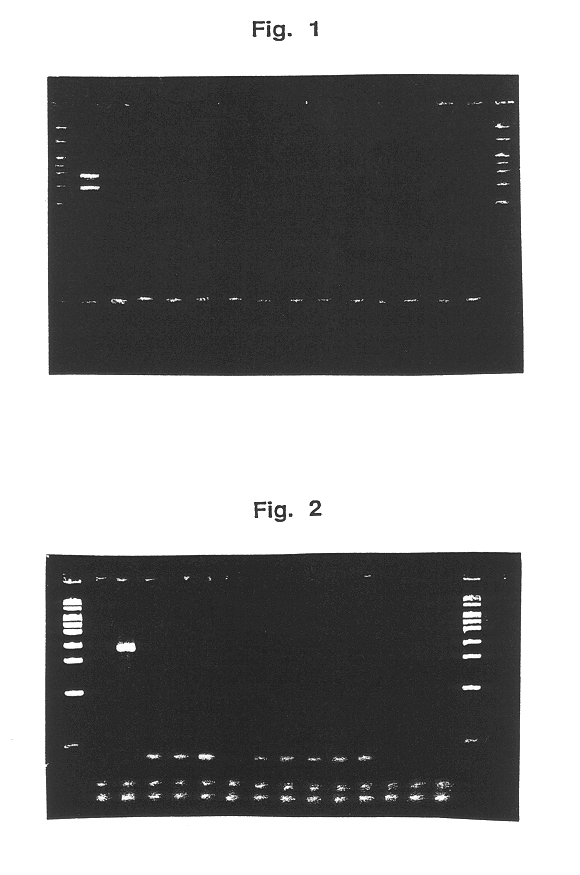Genes for detecting bacteria and detection method by using the same
a technology of genes and bacteria, applied in the field of genes for detecting bacteria and detection methods by using the same, can solve the problems of difficult to obtain the necessary detective sensitivity and selectivity, difficult to obtain bacteria peptides, and difficult to tes
- Summary
- Abstract
- Description
- Claims
- Application Information
AI Technical Summary
Problems solved by technology
Method used
Image
Examples
example 2
Cloning of spacer regions between the gene coding 16S rRNA and the gene coding 23S rRNA of Pectinatus frisingensis, and determination of the base sequences
(1) Selection and synthesis of oligonucleotide primers for amplification of 16S / 23S rRNA spacer region by the PCR method
Since the base sequences of the 16S ribosomal RNA gene of Pectinatus frisingensis were apparent (International Journal of Systematic Bacteriology, Vol. 40, p.p. 19-27 (1990)), the primers were selected on the basis of the 557-576.sup.th base sequences.
Since the base sequences of the 23S ribosomal RNA gene of Pectinatus frisingensis were apparent (Systematic Applied Microbiology, Vol. 15, p.p. 487-501 (1990), EMBL Accession Number X48423), the primers were selected on the basis of the 1-20.sup.th base sequences to obtain corresponding comprehensive sequences. The synthesis was entrusted to Sawady Technology Co., Ltd.
(2) Amplification of 16S / 23S rRNA spacer regions by the PCR method
The Pectinatus frisingensis DNA s...
example 3
Detection of Pectinatus frisingensis by the PCR method
(1) Selection and synthesis of a primer for Pectinatus frisingensis The sequences specific for Pectinatus frisingensis by using DNASIS (tradename of Hitachi Soft Engineering Ltd., Co.) on the basis of SEQ ID NO: 1 and SEQ ID NO: 2 were analyzed. The result selected a sequence of 377.sup.th to 395.sup.th on the gene sequence of the spacer region between the gene coding 16S rRNA and the gene coding 23S rRNA of Pectinatus frisingensis of SEQ ID NO: 1, and a sequence of 195.sup.th to 213.sup.th on the gene sequence of the spacer region between the gene coding 16S rRNA and the gene coding 23S rRNA of Pectinatus frisingensis of SEQ ID NO: 2. (SEQ ID NO: 5.)
In addition, the similar analysis selected a sequence of 361.sup.st to 380.sup.th on the gene sequence of the spacer region between the gene coding 16S rRNA and the gene coding 23S rRNA of Pectinatus frisingensis of SEQ ID NO: 1, and a sequence of 179.sup.th to 198.sup.th on the gene...
example 4
Cloning and determination of the base sequence of the spacer regions between the gene coding 16S rRNA and the gene coding 23S rRNA of Pectinatus cerevisiiphilus
(1) Selection and synthesis of oligonucleotide primers for amplifying 16S123S rRNA spacer regions by PCR
As the base sequence of 16S ribosome RNA gene of Pectinatus cerevisiiphilus is disclosed in International Journal of Systematic Bacteriology, Vol. 40, pages 19-27 (1990), the primers were selected on the basis of the base sequence of 557.sup.th -576.sup.th.
The base sequence of 23 ribosome RNA gene of Pectinatus cerevisiiphilus had not been disclosed, but the base sequence of 23 ribosome RNA gene of Pectinatus frisingensis had been disclosed in Systematic Applied Microbiology, Vol. 15, pages 487-501 (1990), EMBL Accession Number X48423. The primer was selected to obtain the complementary sequence corresponding to the base sequence of 1.sup.st -20.sup.th of 23 ribosome RNA gene of Pectinatus frisingensis. Sawaday Technology w...
PUM
| Property | Measurement | Unit |
|---|---|---|
| temperature | aaaaa | aaaaa |
| temperature | aaaaa | aaaaa |
| volume | aaaaa | aaaaa |
Abstract
Description
Claims
Application Information
 Login to View More
Login to View More - R&D
- Intellectual Property
- Life Sciences
- Materials
- Tech Scout
- Unparalleled Data Quality
- Higher Quality Content
- 60% Fewer Hallucinations
Browse by: Latest US Patents, China's latest patents, Technical Efficacy Thesaurus, Application Domain, Technology Topic, Popular Technical Reports.
© 2025 PatSnap. All rights reserved.Legal|Privacy policy|Modern Slavery Act Transparency Statement|Sitemap|About US| Contact US: help@patsnap.com

